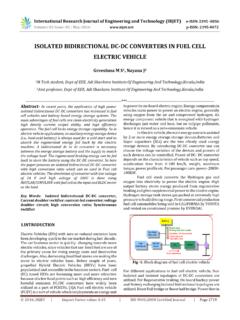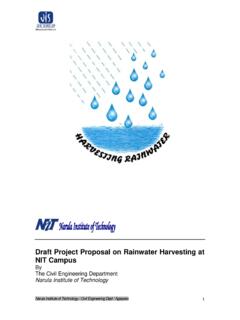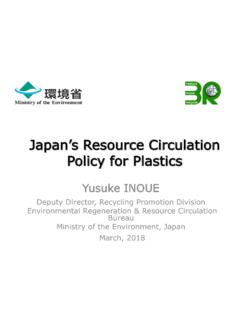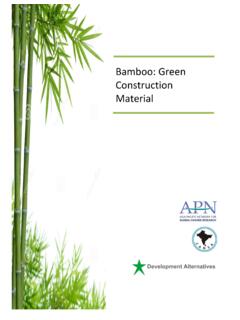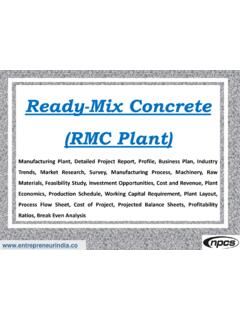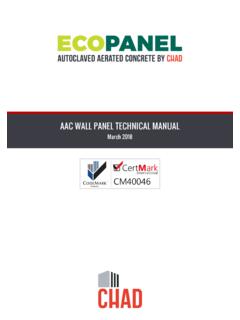Transcription of Study of Plastic Bricks Made From Waste Plastic
1 International Research Journal of Engineering and Technology (IRJET) e-ISSN: 2395-0056. Volume: 06 Issue: 04 | Apr 2019 p-ISSN: 2395-0072. Study of Plastic Bricks Made From Waste Plastic Rajarapu Bhushaiah1, Shaik Mohammad1, D. Srinivasa Rao2. 1UG Student, Department of Civil Engineering, Pace Institute of Technology & Sciences, Ongole. 2 Assosiate Professor Department of Civil Engineering, Pace Institute of Technology & Sciences, Ongole. ---------------------------------------- -----------------------------**--------- ---------------------------------------- --------------------- Abstract - Plastics are key resources in circular economy very useful material that is flexible, robust and rigid they and recycling after the end of useful life with economic value become Waste after their use and they pollute the air and creation and minimal damage to environment is the key to land.
2 Recycling is processing use Waste materials into new their sustainable management. Studies in a large stream of products to prevent Waste of potentially useful materials. researches have explored impregnating Waste plastics in The increase in the popularity of using eco- friendly , low cost concrete and reported encouraging results with multiple and lightweight construction materials in building industry benefits. The present Study makes a critical review of some of has brought about the need to investigate how this can be these findings and gleans some common useful trends in the achieved by benefiting to the environment as well as properties reported in these studies.
3 The Study also presents maintaining the material requirements and their standards. results of experimental work on Bricks made of non-recyclable From the advantages of Plastic recycling procedure is used. Waste thermoplastic granules constituting 0 to 20% by weight, For the production of Plastic Bricks is an optimal method for 4kg of fly ash, cement and sand making up the remainder. The controlling the problem by decomposition of Plastic Waste Bricks were cured under water for 28 days and baked at and also it costs economical for the production of building temperature ranging from 90oC to 110oC for 2 hours.
4 The key materials. In this Study , Plastic Waste from factories will be characteristics of these Bricks are found to be lightweight, used to incorporate with cement and sand to produce sand porous, of low thermal conductivity, and of appreciable Bricks . The Bricks will then be tested to Study the mechanical strengths. Though such Bricks hold promise, no compressive strength, efflorescence and water absorption. similar Study appears to have been reported so far. Unlike In the recent past research, the replacement and addition other processes of making porous Bricks , which usually involve have been done with the direct inclusion of polyethylene, incineration to burn combustible materials in order to form polyethylene terephthalate (PET) bottles in shredded form, pores with implication of high carbon emission, the proposed chemically treated polyethylene-fiber, PET in small particles process is non-destructive in that the Bricks are merely baked form by replacing natural coarse aggregate.
5 Most of at low temperature, sufficient to melt the Waste Plastic that replacements have been done by volume calculation, and gets diffused within the body of the Bricks . The compressive showed the decreased in compressive strength as the strengths after addition of Waste Plastic is same as normal increased Plastic Waste . In this Study , recycled Plastic Waste brick strength. And also reduce the water absorption capacity have been introduced in the form of crushed. The of brick is reduced compare with nominal brick. Efflorescence replacement of Plastic Waste material has been done by values were low than the normal brick.
6 The Bricks are likely to weight. add energy efficiency in buildings and help create economic 2. PRESENT SCENARIO OF Waste GENERATION IN. value to manufacturers, thereby, encouraging the ecosystem of INDIA: Plastic Waste management involving all actors in the value chain. A mathematical model is developed to predict Growth of population has increased our urbanization as a compressive strength of Bricks at varying Plastic contents. The result rising standard of living due to technological Study introduces a new strand of research on sustainable innovations have contributed to an increase both in the thermoplastic Waste management.
7 Quantity and variety of solid wastes generated by industrial, agricultural activities, mining and domestic. Globally the Key Words: Plastic Waste , water absorption, compressive estimated quantity of wastes generation was 12 billion tones strength, efflorescence test, thermoplastic (LDPE). in the year 2002 of which 11 billion tones were industrial wastes and billion tones were municipal solid wastes 1. INTRODUCTION (MSW). About 19 billion tons of solid wastes are expected to be generated annually by the year 2020. Annually, Asia alone Plastic is a very common material that is now widely used by generates billion tons of solid wastes and MSW comprise everybody in the world.
8 Plastic plays a predominant role in 795 million tons of which about 48 (6%) MT are generated reusable in this era, as it is compact and light in weight. in India. MSW generation in India, is expected to reach 300. Common Plastic items that are used are covers, bottles, and Million tones and land requirement for disposal of this Waste food packages. The great problem with Plastic is its would be km2 as against which only km2 were decomposition. Plastic is made of polymer chemicals and occupied in 1997 for management of 48 Million tones. As it is they are non-biodegradable. This means that Plastic will not studied that apart from municipal wastes, the organic wastes decompose when it is placed in earth.
9 Though Plastic is a from agricultural sources alone contribute more than 350. 2019, IRJET | Impact Factor value: | ISO 9001:2008 Certified Journal | Page 1122. International Research Journal of Engineering and Technology (IRJET) e-ISSN: 2395-0056. Volume: 06 Issue: 04 | Apr 2019 p-ISSN: 2395-0072. million tons per year. However, it is reported that about 600 Batching of Plastic million tons of wastes have been generated in India from agricultural sources alone. The Quantity of wastes generated Measurement of materials for making brick is called from agricultural sources are sugarcane baggage, paddy and batching.
10 After collection of materials we separate the types wheat straw and husk, wastes of vegetables, food products, of Plastic and remove any other Waste presented in the tea, oil production, wooden mill Waste , coconut husk, jute collected material and check that any water content in in fiber, groundnut shell, cotton stalk etc. In the industrial sample collected ten proceed for burning. sector inorganic solid Waste could are coal combustion residues, bauxite red mud, tailings from aluminum, iron, Burning of Waste Plastic copper and zinc primary extraction processes. Generation of all these inorganic industrial wastes in India is estimated to After completion batching the Plastic Waste were taken for be 290 million Tons per annum.








